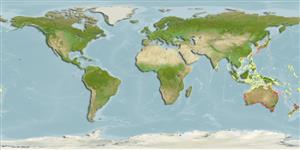>
Gobiiformes (Gobies) >
Gobiidae (Gobies) > Gobiinae
Etymology: Favonigobius: Latin, favonius = gentle, propicious and Latin, favonianus = the west wind; 1656 + Latin, gobius = gudgeon (Ref. 45335).
More on author: Macleay.
Environment: milieu / climate zone / depth range / distribution range
Écologie
marin; saumâtre démersal. Temperate
Western Pacific: eastern Australia, including Tasmania; also in New Zealand (Ref. 5755).
Taille / Poids / Âge
Maturity: Lm ? range ? - ? cm
Max length : 9.0 cm TL mâle / non sexé; (Ref. 9002)
Facultative air-breathing in the genus (Ref. 126274); Found in shallow sandy estuaries, often in seagrass beds (Ref. 9002).
Life cycle and mating behavior
Maturities | Reproduction | Spawnings | Egg(s) | Fecundities | Larves
Kuiter, R.H., 1993. Coastal fishes of south-eastern Australia. University of Hawaii Press. Honolulu, Hawaii. 437 p. (Ref. 9002)
Statut dans la liste rouge de l'IUCN (Ref. 130435)
Menace pour l'homme
Harmless
Utilisations par l'homme
Outils
Articles particuliers
Télécharger en XML
Sources Internet
Estimates based on models
Preferred temperature (Ref.
123201): 14.6 - 26.2, mean 18.6 °C (based on 596 cells).
Phylogenetic diversity index (Ref.
82804): PD
50 = 0.5020 [Uniqueness, from 0.5 = low to 2.0 = high].
Bayesian length-weight: a=0.00708 (0.00333 - 0.01504), b=3.09 (2.92 - 3.26), in cm total length, based on LWR estimates for this (Sub)family-body shape (Ref.
93245).
Niveau trophique (Ref.
69278): 3.5 ±0.4 se; based on size and trophs of closest relatives
Résilience (Ref.
120179): Haut, temps minimum de doublement de population inférieur à 15 mois (Preliminary K or Fecundity.).
Fishing Vulnerability (Ref.
59153): Low vulnerability (10 of 100).
Nutrients (Ref.
124155): Calcium = 235 [111, 875] mg/100g; Iron = 0.968 [0.393, 2.345] mg/100g; Protein = 17.8 [15.6, 19.8] %; Omega3 = 0.328 [0.094, 1.119] g/100g; Selenium = 12.5 [3.5, 42.3] μg/100g; VitaminA = 6.9 [1.2, 36.4] μg/100g; Zinc = 1.98 [1.07, 3.51] mg/100g (wet weight);
